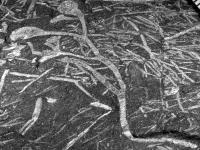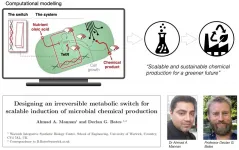(Press-News.org) In "Atchafalaya," John McPhee's essay in the 1989 book The Control of Nature, the author chronicles efforts by the U.S. Army Corps of Engineers to prevent the Atchafalaya River from changing the course of the Mississippi River where they diverge, due to the Atchafalaya's steeper gradient and more direct route to the gulf. McPhee's classic essay proved inspirational to John Shaw, an assistant professor of geosciences who called it "a foundational text."
Indeed, his latest work adds to the story.
In a recent paper published in the American Geophysical Union's journal, Water Resources Research, Shaw and his fellow researchers, Kashauna G. Mason, Hongbo Ma and Gordon W. McClain III, examine the critical period before the decision was made in 1950 to create a river control system at the junction of the two rivers to get a clearer understanding of the rivers' natural state - and how regulation might be fine-tuned moving forward to preserve Louisiana coastlands.
The paper, Influences on Discharge Partitioning on a Large River Delta: Case Study of the Mississippi-Atchafalaya Diversion, 1926-1950, seeks to resolve lingering questions about the rate at which the Atchafalaya River captured water from the Mississippi River and the degree to which it would have changed the course of the river.
"You basically have two conduits to the ocean, and you can think of them as competing for water and sediment. You've got the Mississippi and the Atchafalaya -- anything to widen or grow one branch will pull more water from the other," Shaw said. "More and more water was going down the Atchafalaya, so that was what everybody focused on."
By looking at old Army Corps of Engineers surveys, McCain and Mason were able to painstakingly digitize more than 100,000 data points, bringing historic measurements into the modern field. From this, Ma and Shaw were able to model the hydrodynamic flow through the channel network.
An unexpected finding was that while the Atchafalaya was widening, increasing its flow, the Mississippi was widening, too, just not as fast the Atchafalaya. "That's really interesting," Shaw explained, "because I think most people assumed the Mississippi was shrinking simply because the Atchafalaya was expanding." In short, the situation may not have been as dire as initially thought.
Ultimately, the team found that erosion of the upper Atchafalaya accounted for about 73 percent of the increased water flow, while dredging of the lower part of the river accounted for the remainder, meaning the increased flow was a product of both natural and man-made forces. While man-made controls on the flow are secondary, they weren't properly understood at the time McPhee wrote "Atchafalaya."
Why is this important to know?
As Shaw explains it, Louisiana is slowly being submerged due to rising sea levels and human impact on the river system. Billions of dollars are being spent to prevent that from happening.
The Atchafalaya-Mississippi Diversion is the linchpin to controlling where water and sediment go, whether down one river or the other, and determining which marshes will be nourished by sediment. Hundreds of megatons of sediment come down the Mississippi every year, and if more goes down the Atchafalaya, that impacts the Mississippi and the coastline it shapes.
The ultimate goal of the research is to better understand how these rivers are being regulated and what would happen in the absence of regulation. By focusing on the years between 1926-1950, Shaw and his team are seeking to find a clearer picture of what the river looked like before regulation began -- and how it might be fine-tuned moving forward. This research was funded by a Department of Energy grant to understand river channel dynamics along coastlines.
Now that the paper is done, Shaw wants to send a copy to McPhee, a professor emeritus at Princeton. "I just want to let him know this was inspired by him," he said, "maybe not written so well, but it updates the story he broke to the world in the 80s."
INFORMATION:
Everyone is familiar with tiny gas bubbles gently rising up in sparkling water. But the bubbles that were created by intense focused lasers in this experiment were ten times smaller and contained water vapour at a pressure around a hundred thousand times higher. Under these conditions, the bubble expands at supersonic speed and pushes a shockwave, consisting of a spherical shell of highly compressed water, ahead of itself. Now the research team led by the University of Göttingen, together with the Deutsches Elektronen-Synchroton (DESY) and the European X-Ray Free-Electron Laser (European XFEL), has created such an event and then, with an innovative ...
The analysis of very old plant fossils discovered in South Africa and dating from the Lower Devonian period documents the transition from barren continents to the green planet we know today. Cyrille Prestianni, a palaeobotanist at the EDDy Lab at the University of Liège (Belgium), participated in this study, the results of which have just been published in the journal Scientific Reports.
The greening of continents - or terrestrialisation - is undoubtedly one of the most important processes that our planet has undergone. For most of the Earth's history, the continents were devoid of macroscopic ...
CAMBRIDGE, Mass.--(BUSINESS WIRE)--QurAlis Corporation, a biotech company developing breakthrough precision medicines for ALS and other genetically validated neurodegenerative diseases, today announced the publication of an article in Cell Reports titled Human Amyotrophic Lateral Sclerosis Excitability Phenotype Screen: Target Discovery and Validation by QurAlis founders Kasper Roet, Ph.D., Clifford Woolf, M.D., Ph.D., and Kevin Eggan, Ph.D., who pioneered a high-content, live-cell imaging screen using ALS patient-derived motor neurons in combination with a compound library generated by Pfizer to identify drug targets to treat hyperexcitability induced neurodegeneration ...
A research team from the University of Massachusetts Amherst has created an electronic microsystem that can intelligently respond to information inputs without any external energy input, much like a self-autonomous living organism. The microsystem is constructed from a novel type of electronics that can process ultralow electronic signals and incorporates a device that can generate electricity "out of thin air" from the ambient environment.
The groundbreaking research was published June 7 in the journal Nature Communications.
Jun Yao, an assistant professor in the electrical and computer engineering (ECE) and an adjunct professor in biomedical engineering, ...
DURHAM, N.C. - Using drones and artificial intelligence to monitor large colonies of seabirds can be as effective as traditional on-the-ground methods, while reducing costs, labor and the risk of human error, a new study finds.
Scientists at Duke University and the Wildlife Conservation Society (WCS) used a deep-learning algorithm--a form of artificial intelligence--to analyze more than 10,000 drone images of mixed colonies of seabirds in the Falkland Islands off Argentina's coast.
The Falklands, also known as the Malvinas, are home to the world's largest colonies of black-browed albatrosses (Thalassarche melanophris) and second-largest ...
Researchers from the University of Liège (Belgium) have recently developed a new artificial neuron inspired by the different modes of operation of human neurons. Called a Bistable Recurrent Cell (BRC), this process has enabled recurrent networks to learn temporal relationships of more than a thousand discrete time units where classical methods failed after only a hundred time units. These important results are published in the journal PLOS One.
The enormous interest in artificial intelligence (AI) in recent years has led to the development of extremely powerful machine learning techniques. For example, time series - any series of data where a time component is ...
The speed of water flow is a limiting factor in many membrane-based industrial processes, including desalination, molecular separation and osmotic power generation.
Researchers at The University of Manchester's National Graphene Institute (NGI) have published a study in Nature Communications showing a dramatic decrease in friction when water is passed through nanoscale capillaries made of graphene, whereas those with hexagonal boron nitride (hBN) - which has a similar surface topography and crystal structure as graphene - display high friction.
The team also demonstrated that water velocity could be selectively controlled by covering the high friction hBN channels with graphene, opening ...
DURHAM, N.H.--Why did the deer cross the road? According to research from the University of New Hampshire to keep going and going and going. Researchers have discovered the longest distance ever recorded by an adult male white-tailed deer--300 kilometers, or close to 200 miles, in just over three weeks. The finding has important implications for population management and the transmission of disease, especially chronic wasting disease, a fatal neurological disease.
"Deer are one of the most abundant, well-known and intensely managed species of wildlife in the United States," said Remington Moll, assistant ...
The bad odors produced by the Waste Water Treatment Plants, known as WWTPs, have become a growing concern in the cities and towns that host these facilities and are considered by citizens to be the main cause of the perception of pollution, along with the dust and noise.
Now, and thanks to a collaboration between the Institute for Bioengineering of Catalonia (IBEC) and the company DAM, a new way is being opened to detect and treat these odors.
According to the researchers, "the results obtained in the SNIFFDRONE project (Odor monitoring by drones for environmental purposes) are very positive and represent a significant advance ...
- Most high-value chemicals are currently produced using fossil fuels - industrial chemistry's use of petroleum accounts for 14% of all greenhouse gas emissions.
- An exciting alternative is to engineer bacteria as "cell-factories" with a genetic switch that reroutes their chemistry to produce high-value chemicals, such as biofuels, polymers and pharmaceuticals.
- The use of expensive chemicals to switch them on severely limits their commercial potential, researchers have used mathematical models to develop a new genetic switch that can use a cheap natural ...





